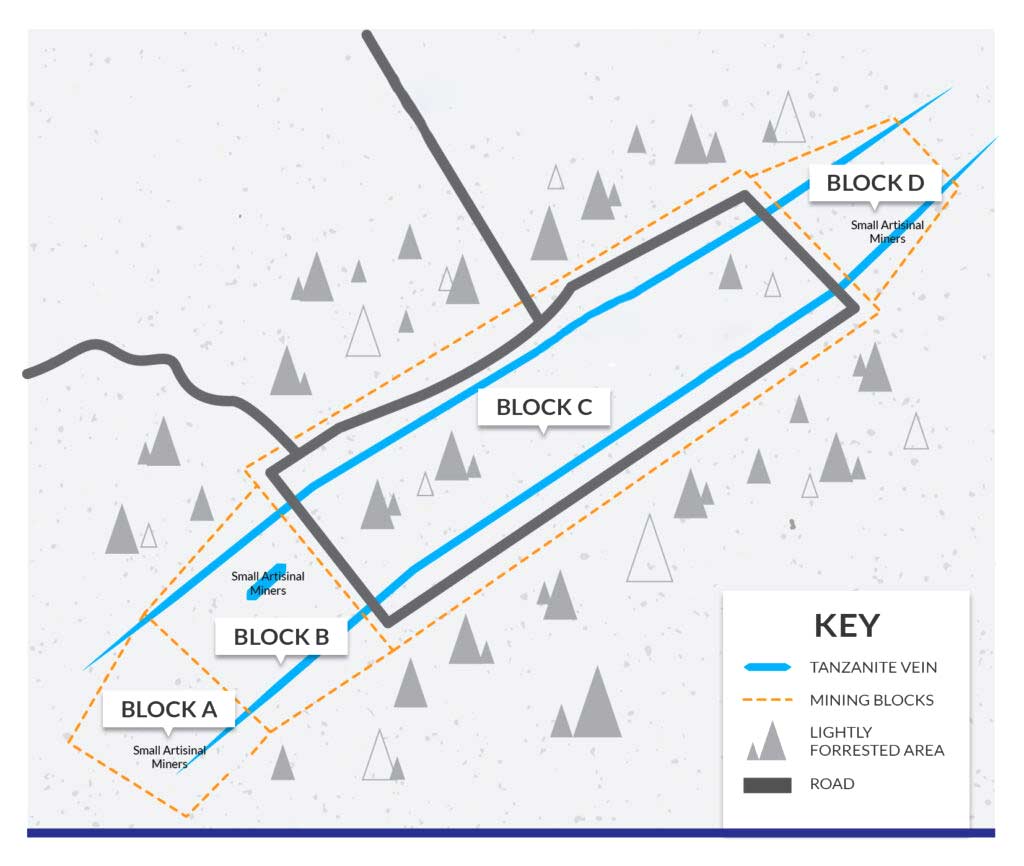How it started?
Tanzanite mining has had a colorful history since Ali Juuyawaatu stumbled upon the blue gemstone in the late 1960s.
In later years, the conflict has developed between the traditional miners and large-scale mining firm Tanzanite One. This article explores the reasons for this.
In the early years, during Tanzania’s dalliance with socialism, the Tanzanite mines were nationalized and run by a state corporation called STAMICO. In 1990, following the demise of socialism in Tanzania, the Tanzanian Government demarcated the mining area; a narrow strip along the Merelani hills, approximately 5 km north of Mererani township, into four Blocks denoted A, B, C, and D as shown below.
Block A was awarded to Kilimanjaro Mines Ltd, Blocks B, and D to small-scale miners through the Arusha Regional Miners Association (AREMA), and Block C to a graphite miner called Graphtan Inc which subsequently went bust in 1996. Africa was at that stage, seeing an influx of South African companies entering local markets as apartheid ended in their own country and they looked further afield for opportunities.
Graphtan’s license to Block C was purchased by a South African company called AFGEM. Using the staff and the equipment of Graphtan, AFGEM started producing Tanzanite in 2001. In 2004 the Tanzanite One group acquired AFGEM’s Tanzanite business and assets.
They ostensibly envisaged using this model to control the supply to market with a view to forcing up prices. They established a well-run and imaginative “pull marketing campaign” in major developed markets designed to create demand at the consumer level using their Tanzanite Foundation marketing arm. This campaign, centered around their “Mark of Rarity”, strongly implied that unless a Tanzanite was purchased from Tanzanite One and carried its “Mark of Rarity” certificate it was of suspect pedigree.
This further alienated the small-scale miners who prior to Tanzanite One’s entrance to the mining area, had been the discoverers and traditional miners of Tanzanite.
The small-scale mining sector in Mererani is concentrated in Block B and Block D. There are approximately 700 mines according to AREMA, each of them holding a Primary Mining License. The PML license is only available for Tanzanian nationals. Block B and D are heavily concentrated and the mines are located
very close to each other. Whilst all work with a PML, the equipment, and technology used vary from mine to mine. The most basic mines only have a literal hole in the ground that they operate with either a ladder or a rope, while some mines use more modern
Working in this sector is no bed of roses. Conditions are tough and working hours long. Most miners work as cooperative groups with a profit share – equal shares of Tanzanite discovered for each miner in the group, but this also means equal shares of nothing when no Tanzanite is found, as frequently happens for months on end in some mining claims. Many miners carry second jobs in farming to alleviate this. This is becoming more prevalent as Tanzanite becomes scarcer and more difficult to find deep down at over 400 meters.
However, contrary to what some believe, small-scale mining is the natural home of most colored gemstone mining (in Sri-Lanka, formerly Ceylon, mining of Sapphires is exclusively reserved by the government for small-scale miners only, for the direct benefit of the local community).
Whilst proponents of large scale mining will argue that small scale mining is inefficient and dangerous, it also ignores the fact that it has been the path out of poverty for many and a very “grassroots” industry open to anyone with the verve to make it work, much as the original Kimberly Diamond deposits were. There are many great success stories and demonizing the sector is to ignore this fact.
As such, we will leave the final word on this subject to world-renowned Gemologists and Explorers Richard Hughes and Vincent Pardieu :
“We ask you this: Which is sadder — the conditions under which the world’s poor eke out an existence, or the self-righteousness of those who have no direct experience with the problem but profess an understanding of the solution. Just who is lacking enlightenment? Next time you set eyes on tanzanite, a jade, a ruby, a diamond, or — dare we say it — a cell phone, understand where it comes from. It is not just of the earth, but also from the blood and sweat of thousands of fellow humans, each in their own way struggling forward in life, trying to make things a little bit better for themselves and their families. Wanna make a difference in their lives? But what they are risking their lives to produce. Now how’s that for activism? How’s that for revolution?”
